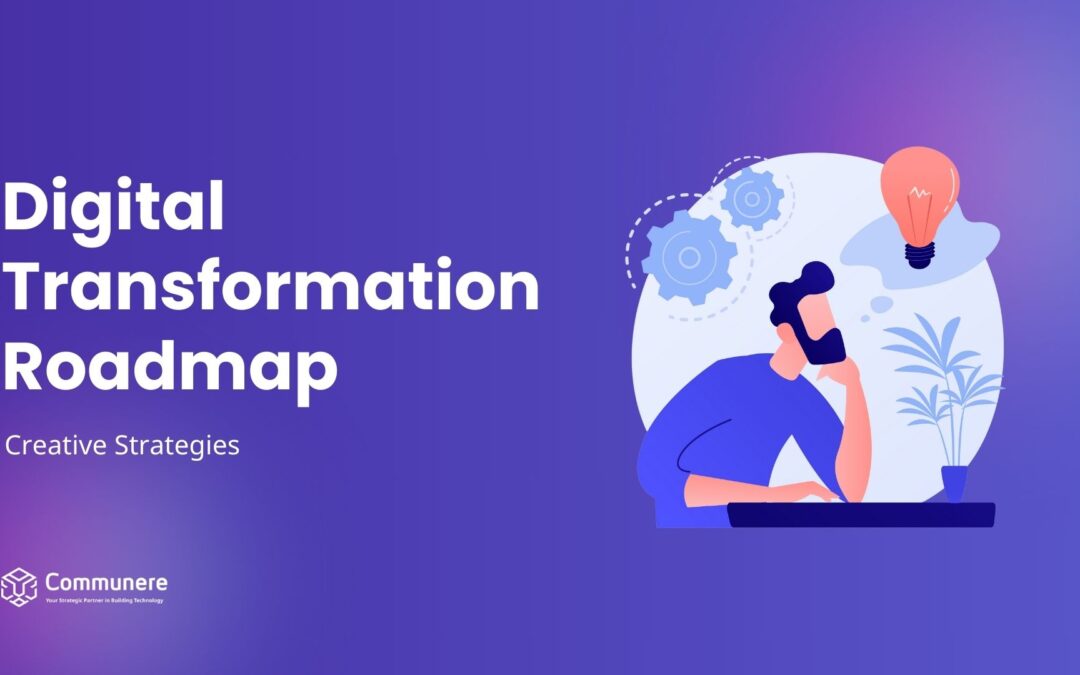Digital transformation is a crucial concept in the modern business world, representing the integration of digital technology into all areas of a business, fundamentally changing how businesses operate and deliver value to customers.
It’s not just about technology; it involves a cultural change that requires organisations to continually challenge the status quo, experiment, and get comfortable with failure. The importance of digital transformation can’t be overstated, as it helps businesses stay competitive, efficient, and relevant in a rapidly changing digital world.
Whether you’re just starting out or looking to refine your digital transformation strategy, understanding the essence of a digital transformation roadmap is your first step towards a successful digital future.
Table of Contents
- What is a Digital Transformation Roadmap?
- 7 Steps to Creating Your Digital Transformation Roadmap
- Digital Transformation Roadmap FAQs
- Digital Transformation Roadmap: A Summary
What is a Digital Transformation Roadmap?
It’s a strategic guide that helps businesses integrate digital technologies seamlessly into their operations. Think of it as your GPS for navigating the complex digital world. It’s not a one-size-fits-all approach but rather a tailor-made strategy that aligns with your unique business needs.
Simply put, it’s the process of using digital technologies to create or modify existing business processes, culture, and customer experiences. It’s all about reinventing how you operate and delivering value to your customers with a touch of digital innovation.
Why is digital transformation so significant, you ask? Well, it’s the key to staying competitive and relevant in today’s fast-paced world. It’s not just about embracing new technologies; it’s about a mindset shift, a cultural change. It’s about daring to challenge traditional business methods, experimenting boldly, and learning to embrace failure as a stepping stone to success.
7 Steps to Creating Your Digital Transformation Roadmap
An effective digital transformation roadmap is a strategic plan that outlines how a business can integrate digital technologies. It’s a blueprint for transforming processes, operations, and strategies through digital methodologies.
Understanding Your Current State
But before you leap into the world of digital transformation, it’s crucial to understand where you currently stand. Think of it as checking your compass before setting sail. This stage is all about taking a deep dive into your existing landscape – the technologies you use, the processes you follow, and the overall efficiency of your operations.
Conducting a Technology Inventory
Start by taking stock of the technology you already have. What software and hardware are you using? Are these systems talking to each other effectively or living in isolation like distant islands? This inventory isn’t just about listing out tools and applications; it’s about understanding how they contribute to (or hinder) your business objectives.
Process Analysis: The Nitty-Gritty of Your Operations
Next up, dissect your processes. How do things get done in your organisation? Are there steps that are outdated or redundant? Sometimes, processes evolve over time, becoming a complex web that’s hard to untangle. This step is about identifying inefficiencies, bottlenecks, and areas where digital solutions could streamline operations.
Spotting the Pain Points
No journey is without its bumps, and your current state is likely to have a few. These pain points could be anything from slow response times to customer queries, fragmented customer data, or even employee frustration with outdated systems. Recognizing these pain points is vital because they are often the catalysts for transformation.
Gap Analysis: Where Are You Falling Short?
Gap analysis is like looking in a mirror and being honest about what you see. Where is your business falling short in terms of customer experience and operational efficiency? Maybe your customers are looking for more personalised experiences, or perhaps your employees are bogged down by manual tasks that could be automated.
Measuring Employee Productivity
Your employees are your biggest asset, and their productivity is a key indicator of your operational health. Are they spending too much time on manual, repetitive tasks? Do they have the tools they need to work efficiently and collaboratively? Remember, digital transformation is as much about people as it is about technology.
Defining Digital Transformation Objectives
As we delve deeper into the realm of digital transformation, it’s time to talk about setting your sails in the right direction. This means defining your digital transformation objectives. It’s not just about picking a destination; it’s about charting a course that’s clear, measurable, and, most importantly, aligned with your overall business strategy.
Setting Clear and Measurable Goals
The goals you set will be the lighthouse guiding your digital transformation journey. But these aren’t just any goals; they need to be SMART – Specific, Measurable, Achievable, Relevant, and Time-bound. For instance, instead of a vague goal like “improve customer service,” aim for something more tangible like “reduce customer service response time from 24 hours to 2 hours within six months.”
Enhancing Customer Engagement
In the digital era, customer engagement goes beyond just meeting needs; it’s about exceeding expectations. Set objectives to leverage digital tools for deeper insights into customer behaviour, preferences, and feedback. This could mean implementing a new CRM system, using data analytics to personalise customer interactions, or introducing chatbots for instant customer support.
Improving Operational Efficiency
One of the most tangible benefits of digital transformation is improved operational efficiency. Identify areas in your operations where digital solutions could make processes faster, reduce costs, or enhance quality. Goals could include automating manual tasks, improving supply chain management, or adopting cloud solutions for better collaboration.
Accelerating Innovation
Digital transformation opens up a world of possibilities for innovation. Set goals to explore and implement emerging technologies like AI, IoT, or blockchain to create new products, services, or business models. Remember, innovation in the digital age is not just about technology; it’s also about thinking creatively to solve old problems in new ways.
Aligning with Business Strategy
Perhaps the most crucial aspect is ensuring that your digital transformation objectives dovetail with your broader business strategy. Each goal should be a step towards not just a more digital, but a more successful business. If your objective doesn’t contribute to your overall business vision, it might be time to rethink it.
Stakeholder Involvement
Creating a digital transformation roadmap is like setting sail on a vast ocean. To navigate these waters successfully, you need a dedicated crew, each member bringing their unique skills to the deck. This is where stakeholder involvement becomes pivotal. A successful digital transformation isn’t a one-department affair; it demands the collaboration and commitment of various teams across your organisation.
Building a Cross-Functional Transformation Team
The first step is to assemble a dream team composed of members from leadership, IT, operations, marketing, HR, and any other relevant department. Why such diversity? Because digital transformation impacts every corner of your organisation. The IT staff brings technical expertise, operations provide insights into business processes, marketing adds customer-centric perspectives, and HR ensures that employee needs and changes are managed effectively.
Gaining Leadership Buy-In
Leadership buy-in isn’t just important; it’s essential. When leaders champion digital transformation, it sends a powerful message throughout the organisation. Their support can provide the necessary resources, remove barriers, and drive a culture that embraces change. Leaders can be the lighthouse guiding the organisation through the digital transformation journey.
Involving Key Departments
IT is a no-brainer; they’re your tech gurus. Operations will help in redefining processes for digital compatibility. Marketing can leverage digital tools for better customer engagement, and HR is crucial for managing the change in work culture and upskilling employees. Each department plays a unique role, like cogs in a well-oiled machine.
Communicating the Vision to All Employees
Communication is the wind in the sails of your transformation journey. Communicating the vision, goals, and benefits of the digital transformation to all employees is crucial. This isn’t just about sending a company-wide email; it involves ongoing dialogue, addressing concerns, and celebrating milestones. When employees understand the transformation’s ‘why’ and ‘how’, they’re more likely to hop on board and row in unison.
Creating a Culture of Involvement and Innovation
Encourage a culture where every employee feels they are part of this transformation journey. Create platforms for sharing ideas, feedback, and concerns. When people feel heard and involved, they’re more likely to contribute positively and embrace change.
Technology Selection and Integration
Selecting and integrating the right technologies into your business is like choosing the right equipment for a sea expedition. You need tools that not only fit the journey ahead but also work seamlessly with what you already have on board. This stage of creating your digital transformation roadmap is all about evaluating emerging technologies like cloud computing, AI, and IoT, ensuring they align with your business needs, and integrating them in a way that scales and adapts as you grow.
Evaluating Emerging Technologies
The digital landscape is brimming with innovations, but not every shiny new technology is right for your voyage. It’s essential to evaluate each one based on how it can address your specific business challenges and goals. For instance, cloud computing offers flexibility and scalability, AI can provide deep insights and automation capabilities, and IoT can enhance connectivity and data collection. Choose technologies that not only solve your current problems but also open new avenues for growth and innovation.
Ensuring Compatibility with Existing Systems
Imagine trying to fit a square peg in a round hole – that’s what it’s like integrating new technology with incompatible existing systems. The key is to ensure that new technologies can smoothly integrate with your current setup. This might involve upgrading legacy systems or finding middleware that can bridge old and new. Compatibility is crucial to avoid creating new siloes or bottlenecks.
Scalability: Planning for Growth
Your business isn’t static, and neither should be your technology. As you evaluate options, think about scalability. Can this technology grow with your business? Will it be able to handle increased loads, more data, or new business units? Scalable solutions help ensure that your digital infrastructure won’t become obsolete as your business expands.
Creating a Phased Integration Plan
Diving headfirst into a full-scale technology overhaul can be overwhelming. A phased integration plan allows for a more manageable approach. Start with pilot projects or integrate new technologies in stages. This not only makes the process less daunting but also allows you to learn and adapt as you go. Monitor each phase closely, measure its impact, and use these insights to inform the next steps.
Preparing for Challenges
No journey is without its hurdles, and technology integration is no different. Be prepared for possible challenges arising from digital transformation, such as resistance to change, technical issues, or compatibility hiccups. Having a flexible mindset and a problem-solving approach is key.
Data Security and Privacy
ِData security and privacy are akin to safeguarding the treasure chest of your ship. Protecting your organisation’s and customers’ data becomes paramount as you sail through the digital seas. This isn’t just about erecting walls; it’s about creating a culture of security and understanding that data is your most valuable asset while creating a digital transformation roadmap.
Assessing Risks: Understanding the Threat Landscape
The first step in data protection is understanding the risks. This involves identifying sensitive data, understanding where it resides, how it is used, and who has access to it. Assess the potential threats, be it cyberattacks, data breaches, or internal vulnerabilities. Think of it as mapping out the stormy areas of your journey where you need to be extra vigilant.
Implementing Robust Security Measures
Once you know the risks, it’s time to fortify your defences. This includes a range of measures like firewalls, encryption, intrusion detection systems, and secure access controls. But technology alone isn’t enough. You also need robust policies and procedures for data handling, backup, and recovery. It’s like training your crew and equipping your ship to withstand the fiercest of digital storms.
Ensuring Regulatory Compliance
The digital sea is governed by various laws and regulations, like GDPR, HIPAA, or CCPA, designed to protect consumer data. Compliance isn’t just about avoiding fines; it’s about building trust with your customers by showing that you value and protect their data. Regular audits, staying updated with regulatory changes, and incorporating compliance into your data practices are crucial.
Educating and Empowering Employees
Your crew plays a crucial role in data security. Human error is often a major vulnerability in data breaches. Regular training, awareness programs, and clear guidelines help create a security-conscious culture. Ensure every member of your team understands their role in protecting data and the best practices to do so.
Continuously Monitoring and Updating Security Practices
The threat landscape in the digital world is constantly evolving. Regularly review and update your security measures. This includes monitoring networks for suspicious activities, conducting security audits, and updating systems against the latest vulnerabilities.
Change Management
In the voyage of digital transformation, change management is the rudder that helps steer your ship through the often choppy waters of change. It’s not just about implementing new technologies or processes; it’s about guiding your people through the transformation. Developing a comprehensive change management strategy is essential to ensure that the transition is smooth, effective, and sustainable.
Developing a Comprehensive Change Management Strategy
A good change management strategy is like a detailed map for your journey. It should outline the steps to manage the human aspect of the transformation. This includes anticipating challenges, planning for different phases of the change, and ensuring alignment with your overall digital transformation goals. Remember, change management is about leading people, not just following processes.
Employee Training Programs: Equipping Your Crew
As you embark on new digital initiatives, your crew needs to be skilled to handle the new tools and processes. Training programs are crucial. They should be tailored to different roles and departments, ensuring that each team member has the skills and knowledge needed to navigate the new digital environment effectively. Think of it as arming your sailors with the right gear and navigation skills.
Effective Communication Plans: Keeping Everyone Informed
Communication is the compass that keeps everyone oriented and moving in the right direction. Effective communication plans should articulate the why, what, and how of the changes. Regular updates, open forums for feedback, and clear channels for questions and concerns help keep the lines of communication open. Transparency in communication builds trust and helps in mitigating fears or misunderstandings about the transformation.
Overcoming Resistance to Change
Resistance to change is like the undercurrent that can subtly undermine your transformation efforts. It’s important to address concerns and fears head-on. This can involve one-on-one discussions, addressing misconceptions, involving employees in decision-making, and highlighting the benefits of the change. Recognizing and rewarding adaptability and positive contributions to the change process can also be highly effective.
Continuous Support and Reinforcement
Change management doesn’t end with the rollout of new systems or processes. Continuous support, monitoring, and reinforcement are necessary to ensure lasting change. This includes ongoing training, support structures like help desks or mentoring programs, and mechanisms to gather and act on feedback.
Monitoring and Evaluation
As you create your digital transformation roadmap, monitoring and evaluation act as the compass and sextant, guiding you and ensuring you’re on the right track. It’s not enough to set sail with a good plan; you need to continuously track your progress, assess the effectiveness of your strategies, and make course corrections as needed. Establishing Key Performance Indicators (KPIs), setting up systems for continuous monitoring, and creating feedback loops are critical for ensuring that your digital transformation journey is successful and delivers the intended results.
Establishing Key Performance Indicators (KPIs)
KPIs are like the stars by which sailors of old navigate; they guide you towards your destination. In the context of digital transformation, KPIs help in measuring the impact of your initiatives. These should be specific, measurable, achievable, relevant, and time-bound. Whether it’s an increase in customer satisfaction scores, operational efficiency improvement, or digital sales growth, your KPIs should reflect your digital transformation objectives.
Continuous Monitoring: Keeping a Watchful Eye
Setting up systems for continuous monitoring is like having a lookout at the crow’s nest. These systems help you keep a watchful eye on your performance metrics. Monitoring shouldn’t be limited to IT systems; it should encompass business outcomes, employee adoption, and customer feedback. Tools like dashboards, real-time analytics, and performance reports can provide valuable insights into how well your digital initiatives are performing.
Creating Feedback Loops: Listening and Adapting
Feedback loops are essential for understanding the effectiveness of your transformation efforts. They involve gathering feedback from various stakeholders – employees, customers, and business partners. This feedback should be used to inform and refine your strategies. It’s like adjusting your sails based on the wind and currents. For instance, if employee feedback indicates a struggle with a new system, additional training or system refinement may be necessary.
Making Iterative Adjustments
Digital transformation is not a set-and-forget voyage; it’s an iterative process. Based on the insights from your KPIs and feedback, you’ll need to make adjustments to your roadmap. This could involve scaling up successful initiatives, addressing areas that are lagging, or pivoting your strategy in response to new challenges or opportunities. It’s about being agile and responsive to the conditions of your journey.
Celebrating Milestones
Don’t forget to celebrate the milestones! Acknowledging and celebrating successes along the way boosts morale and reinforces the value of the digital transformation efforts. It’s like celebrating the sighting of land after a long voyage, a moment that re-energizes the crew for the journey ahead.
Digital Transformation Roadmap FAQs
What is digital transformation mapping?
Digital transformation mapping refers to the process of creating a roadmap that outlines the steps a business will take to integrate digital technology across its operations.
Digital Transformation Roadmap: A Summary
In summary, a digital transformation roadmap is a strategic plan that guides businesses through the complex process of integrating digital technology. It requires a thorough understanding of the current state, clear objectives, stakeholder involvement, careful technology selection, attention to data security, effective change management, and ongoing monitoring.
Adopting a proactive approach to digital transformation is essential for businesses to remain competitive and relevant in a digital-first world.
The roadmap is not a one-time plan but a continuous journey of adaptation and improvement.




![Why Custom Web Development is the Best Approach [2024]](https://resources.communere.com/wp-content/uploads/2024/02/Why-Custom-Web-Development-is-the-Best-Approach-1024x570.jpg)

